Getting Started with Windows Forms skins (SkinManager)
26 May 20237 minutes to read
This section briefly describes how to create a new Windows Forms project in Visual Studio and apply themes using the SkinManager component.
Assembly deployment and theme assemblies
SkinManager presents in the Syncfusion.Shared.Base assembly.
| Theme name | Assembly name |
|---|---|
| Office2016Theme | Syncfusion.Office2016Theme.WinForms.dll assembly reference is needed only for the SfDataGrid, SfButton, SfDateTimeEdit, SfNumericTextBox, SfToolTip, and SfSmithChart controls only. |
| Office2019Theme | Syncfusion.Office2019Theme.WinForms.dll |
| HighContrastTheme | Syncfusion.HighContrastTheme.WinForms.dll |
| Other Themes | Themes are included in the control assembly itself. |
Loading theme assemblies
Skin manager loads theme assembly using the LoadAssembly method before applying theme. This is applicable for the themes loaded from separate assembly, and not applicable for the themes loaded from built-in assembly.
// Loading Office2019Theme assembly
SkinManager.LoadAssembly(typeof(Office2019Theme).Assembly);
//Loading HighContrastTheme assembly
SkinManager.LoadAssembly(typeof(HighContrastTheme).Assembly);
// Loading Office2016Theme assembly
SkinManager.LoadAssembly(typeof(Syncfusion.WinForms.Themes.Office2016Theme).Assembly);' Loading Office2019Theme assembly
SkinManager.LoadAssembly(GetType(Office2019Theme).Assembly)
' Loading HighContrastTheme assembly
SkinManager.LoadAssembly(GetType(HighContrastTheme).Assembly)
' Loading Office2016Theme assembly
SkinManager.LoadAssembly(GetType(Syncfusion.WinForms.Themes.Office2016Theme).Assembly)Adding skin manager component
Through designer
1) Create a new Windows Forms application in Visual Studio.
2) The SkinManager component can be added to designer by dragging it from the toolbox to the design view.
The following dependent assemblies will be added automatically:
- Syncfusion.Shared.Base
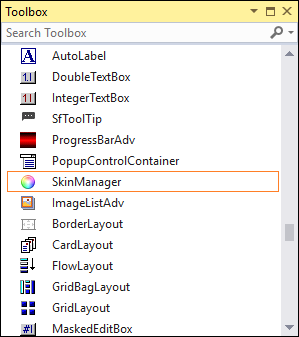
Applying theme
After the SkinManager component has been added into the designer, select the SkinManager component, and go to properties window. Here, you can apply theme for a control or form using the Controls property.
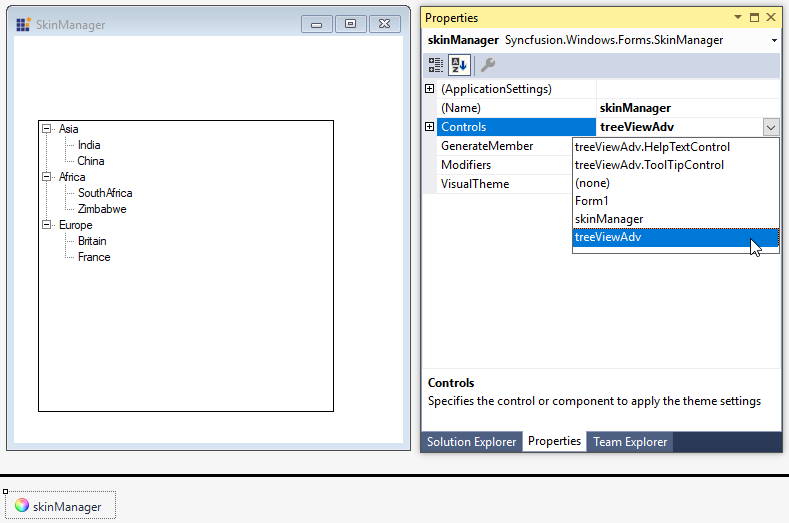
NOTE
SkinManager does not support the custom themes ( themes generated using ThemeStudio). It works only with predefined themes.
Applying theme to the form
Skin manager supports to apply theme for all the control in the form or a container by applying theme to the form or container. So, you do not need to apply theme for each control.
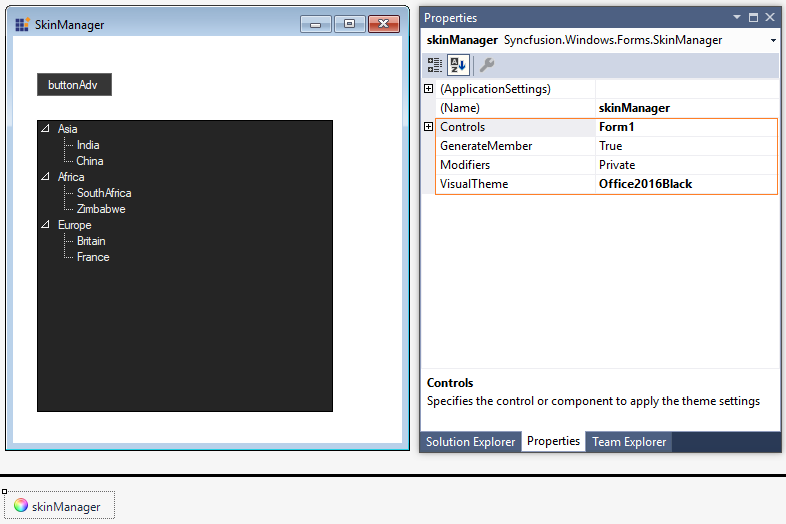
Through code
Theme for a control or form can be applied by settings Controls property of SkinManager.
using Syncfusion.Windows.Forms;
this.components = new System.ComponentModel.Container();
SkinManager skinManager1 = new SkinManager(this.components);
skinManager1.Controls = treeViewAdv1;Imports Syncfusion.Windows.Forms
Me.components = New System.ComponentModel.Container()
Dim skinManager1 As New SkinManager(Me.components)
skinManager1.Controls = treeViewAdv1Applying theme to the form
Skin manager supports to apply theme for all the control in the form or a container by applying theme to the form or container. So, you do not need to apply theme for each control.
skinManager1.Controls = this;
skinManager1.VisualTheme = VisualTheme.Office2016Black;skinManager1.Controls = Me
skinManager1.VisualTheme = VisualTheme.Office2016Black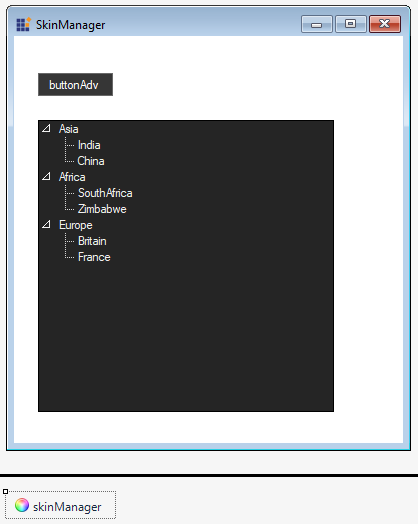
Apply Themes to entire application
Skin manager allows to apply theme for all the controls and forms in an application by setting the ApplicationVisualTheme property. It allows you to theme entire application using single ApplicationVisualTheme property.
static void Main()
{
SkinManager.ApplicationVisualTheme = "Office2019Colourful";
Application.EnableVisualStyles();
Application.SetCompatibleTextRenderingDefault(false);
Application.Run(new Form1());
}NOTE
Set the
ApplicationVisualThemeproperty before main form is initialized.
Apply theme for individual control
Theme can be applied to individual component using skin manager or by setting the ThemeName property. You need to call the LoadAssembly method for required themes when applying using the ThemeName property also.
this.treeViewAdv1.ThemeName = "Office2019Colorful";Me.treeViewAdv1.ThemeName = "Office2019Colorful"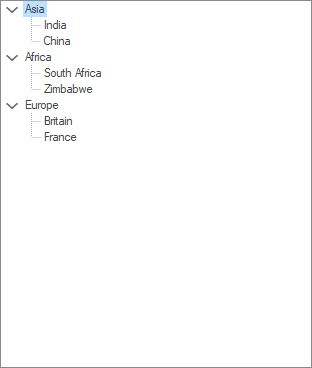
Theme studio based themes
The Office2019Colorful and HighContrastBlack themes can be customized using the WinForms theme studio. Refer to the theme studio documentation to know how to create custom themes.
NOTE
Appearance customization settings done in control level will not take effect when theme studio based theme is applied. So, for customization, refer to the Style section.
Change font for entire application
When using theme studio based themes, the font for entire application can be customized by setting the CanOverrideFontFamily property to true. This property is used only in constructor.
FontHelper.CanOverrideFontFamily = true;
FontHelper.FontFamily = new FontFamily("Algerian");FontHelper.CanOverrideFontFamily = True
FontHelper.FontFamily = New FontFamily("Algerian")
Styles
When using theme studio based themes, the appearance for each control or component can be customized using the ThemeStyle property.
NOTE
If the control name starts with Sf, you can access appearance properties using the
Styleproperty, and for the remaining controls, use theThemeStyleproperty.
For example, in the following code, different style of each control has been changed.
this.treeViewAdv1.ThemeStyle.BackColor = System.Drawing.Color.White;
this.treeViewAdv1.ThemeStyle.BorderColor = System.Drawing.Color.SteelBlue;
this.treeViewAdv1.ThemeStyle.LineColor = System.Drawing.Color.DarkBlue;
this.treeViewAdv1.ThemeStyle.TreeNodeAdvStyle.ArrowColor = System.Drawing.Color.Aqua;
this.treeViewAdv1.ThemeStyle.TreeNodeAdvStyle.TextColor = System.Drawing.Color.Red;Me.treeViewAdv1.ThemeStyle.BackColor = System.Drawing.Color.White
Me.treeViewAdv1.ThemeStyle.BorderColor = System.Drawing.Color.SteelBlue
Me.treeViewAdv1.ThemeStyle.LineColor = System.Drawing.Color.DarkBlue
Me.treeViewAdv1.ThemeStyle.TreeNodeAdvStyle.ArrowColor = System.Drawing.Color.Aqua
Me.treeViewAdv1.ThemeStyle.TreeNodeAdvStyle.TextColor = System.Drawing.Color.Red
Overriding user customization when applying theme
You can customize the appearance of control using the Style or ThemeStyle property when using theme studio based themes. Syncfusion control provides option whether theme can override style settings using the CanOverrideStyle property.
For example, in the following code, TreeView fore color is customized, and theme is applied after that line. If you run the application, theme will not override the fore color settings since the default value of CanOverrideStyle is false. If you set the CanOverrideStyle property to true before setting the theme, then fore color setting will be overridden by theme.
this.treeViewAdv1.CanOverrideStyle = false;
this.treeViewAdv1.ThemeName = "Office2019Colorful";
this.treeViewAdv1.ThemeStyle.TreeNodeAdvStyle.TextColor = System.Drawing.Color.Red;Me.treeViewAdv1.CanOverrideStyle = False
Me.treeViewAdv1.ThemeName = "Office2019Colorful"
Me.treeViewAdv1.ThemeStyle.TreeNodeAdvStyle.TextColor = System.Drawing.Color.Red